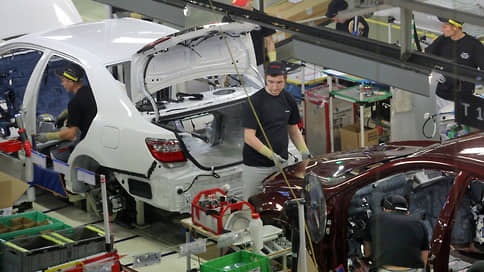Taxi says goodbye to Toyota
[ad_1]

Against the background of the closure of the Japanese Toyota plant in Russia, the market is losing one of the key local models – Camry. Now in the Russian Federation there are almost no stocks of non-mass sedans left. Although such cars are significantly inferior to the crossover (SUV) segment in terms of sales, analysts note the need to replace the Camry, including taxis. A number of them believe that Chinese brands will enter the D segment in the near future. Other interlocutors of Kommersant note that it will be difficult to repeat Toyota’s success with positioning: so far only Kia has succeeded with the K5 model. The fate of the Toyota plant is even less certain: there is an excess of capacity on the market and a shortage of projects.
Closing of the Toyota plant amid supply problems, about which “Kommersant” wrote on September 23 and which the concern later officially confirmed, could threaten Russia with the loss of key models for its market. “After six months of downtime, the company does not see a realistic opportunity to resume production in the future,”— says in a Toyota statement.
The Toyota Motor plant in Shushary (Petersburg) is one of the first own productions of foreign auto concerns in the Russian Federation: previously only Ford was launched in Vsevolozhsk (Leningrad region, it stopped producing cars in 2019). At the same time, if the American concern has been producing models of the C (Focus) and D (Mondeo) segments since 2002, then Toyota has relied on the D (Camry) and SUV (RAV4) segments, despite the popularity of the Corolla model (C segment). As a result, the C segment in Russia began to shrink, and already in 2014, Corolla, like Focus, left the top 25 best-selling car market models. Camry and RAV4 have remained popular in the market in recent years.
Camry “due to successful positioning” compared to the same Mondeo, even in segment D, which is limited in capacity, began to generate good volumes, says automotive expert Vladimir Bespalov. He notes that the car was actively supplied, including in a taxi.
Kommersant’s sources in the car market note that the Camry “entered the cultural code”, recalling the trends in social networks under the lines “only a mother and Camry 3.5 are worthy of love.”
Now, along with the closure of the Toyota plant in Shushary and against the backdrop of the ongoing suspension of car deliveries to the Russian Federation, the market is losing this key model of the D segment.
In recent years, Kia Optima / K5 had similar sales volumes, but there is also no certainty on deliveries. In fact, now the Russian car market cannot offer a choice to buyers of sedans: Chinese automakers, which continue deliveries and production in the Russian Federation, offer only cars in the SUV segment. Vladimir Bespalov believes that the focus on segment D in the Russian market is unlikely to be done by any of the existing or new Chinese brands. “After all, this is not a growing segment of SUVs and not a mass segment B,” says Mr. Bespalov. “Despite the higher marginality compared to mass cars, certain volumes are needed to ensure the economy of such a project. It’s not a fact that anyone will be able to correctly position the model here and actively develop.”
However, Sergey Udalov from Avtostat notes that in the mass segment it is difficult to imagine something cheaper than Lada on the market. He believes that, despite the main bet on SUVs, Chinese automakers will enter the market with D-segment sedans.
“Theoretical replacement of the Camry could be due, among other things, to the high residual value of sedans as a more understandable product and the need for a taxi car in this segment as more suitable than SUVs,” he notes.
Analysts find it difficult to predict the possible fate of the Toyota plant after conservation. Thus, Vladimir Bespalov notes that the plant, obviously, cannot be sold for significant money due to the presence of other vacant idle areas. He notes that, in theory, the site can be purchased for the localization of components – this happened with the Ford plant in Vsevolozhsk. In principle, if there is a candidate for the production of cars, the site where welding, painting and stamping were performed can be adapted for the production of another brand, although the equipment will in any case have to be partially replaced, such as stamping, he argues.
Alexander Beglov, Governor of St. Petersburg, September 23:
“I can say that the industry of St. Petersburg, enterprises of the military-industrial complex need qualified personnel, so people who leave Toyota can and will be in demand there.”
Although the authorities of St. Petersburg are participating in the discussion of a possible transfer of the asset, analysts interviewed by Kommersant doubt that a project similar to the Moskvich plant will be created on the basis of the site (Renault transferred the plant for a ruble to the Moscow government along with its legal entity Renault Russia and staff). The main buyer of Moskvich products should be car sharing parks. Vladimir Bespalov adds that the car sharing segment in St. Petersburg is not as big in absolute terms as in Moscow.
[ad_2]
Source link





